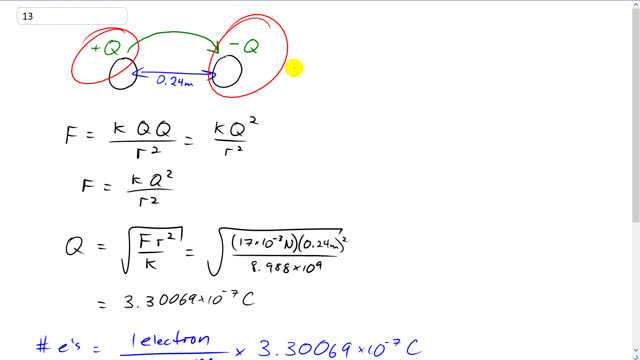
A charge Q is transferred from an initially uncharged plastic ball to an identical ball 24 cm away. The force of attraction is then 17 mN. How many electrons were transferred from one ball to the other?

In order to watch this solution you need to have a subscription.
This is Giancoli Answers with Mr. Dychko. So we're taking some charge from this ball and putting it onto this sphere here. So this one becomes positive because it's lost some electrons and we're putting those electrons in this sphere making it negative and the magnitude of the charge and each sphere will be equal it is going to have opposite signs. So they both can have a magnitude of Q for a net charge. They are 24 centimeters apart which is 0.24 meters. And so the force between them, force of attraction is going to be coulombs constant times the charge in one sphere multiply by the charge in the other sphere and the both Q divided by the distance between them squared. We have K Q squared over r squared and we can solve this for Q By multiplying both sides by r squared and dividing both sides by K and then square rooting. So Q is F r squared over K square rooted so the square root of 17 milli Newtons which is times ten to the negative three Newtons times 0.24 meters separation squared divided by coulombs constant 8.988 times ten to the nine and that gives 3.30069 times ten to the minus seven coulombs is the amount of charge that was transferred. So the number of electrons that corresponds to we have to multiply that number of columns by one electron for every 1.602 times ten to the minus 19 coulombs and this gives about 2.1 times ten to the 12 electrons were transferred.
This is not problem 13, 7th edition
Hi ragnarlaki, thanks for the comment. This is #13 in my copy of the 7th Edition. Are you using the "Global Edition", perhaps? Solutions for that are here: https://www.giancolianswers.com/giancoli-physics-7th-global-edition-cha…. If not, I'd be curious as to what the ISBN is for your copy of the textbook.
Best wishes,
Mr. Dychko
Oh I’m sorry, I didn’t realize I had the global edition
No worries, and thanks for letting me know that solved the problem!